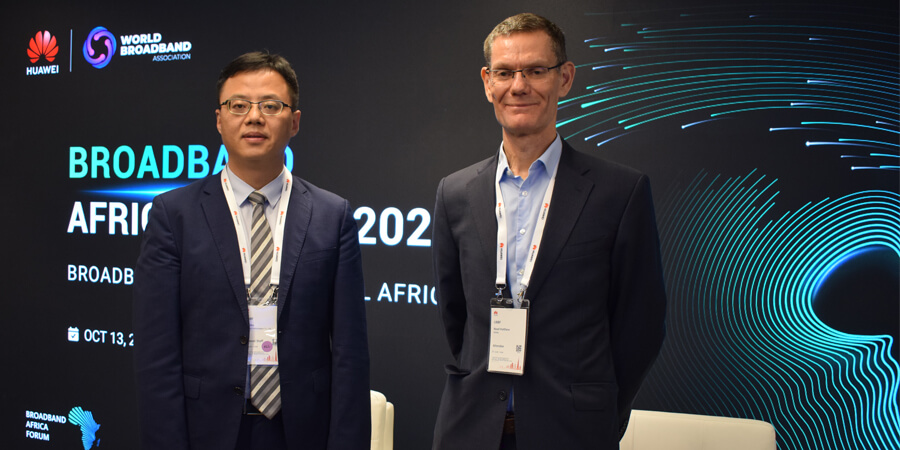During the Broadband Africa Forum 2023, Telecom Review conducted an interview with Gary Lu, President of Network Marketing and Solutions Sales at Huawei. The host, Mathew Reed, Chief Analyst of Service Provider Markets at Omdia, led a discussion on broadband development in Africa, all-optical development in Africa, and other interesting topics.
Advancements in All-Optical Broadband Development in Africa
While discussing broadband development in Africa, Gary Lu highlighted that optical broadband infrastructure has started to take shape in the region. He further explained that the number of FTTH (Fiber-to-the-Home) home passes in Africa is projected to exceed 18 million by the end of this year. Over the next five years, it is anticipated that an average of 6 to 7 million new optical fiber lines will be deployed annually.
Lu emphasized that many African countries recognize the social and economic benefits of all-optical development and have incorporated it into their national development strategies. He cited examples such as Egypt's Fiber to Everywhere strategy, Mauritania's all-optical capital development plan and Cape Verde's all-optical national vision as indicative of the widespread acceptance of all-optical infrastructure within the ICT industry in Africa.
Through the implementation of innovative solutions, Lu further noted that end-to-end network construction costs have been reduced, and the capabilities of industry professionals have seen significant improvements. As a result, the large-scale expansion of all-optical networks in Africa appears imminent.
All-Optical Broadband and the Digital Economy
Since all-optical construction and development are widely recognized in Africa, Mathew Reed inquired about suggestions or reference cases that could expedite all-optical development in the region.
In response, Gary Lu pointed out that in several leading markets in Africa, the average home broadband speed has surpassed 50 Mbit/s, with an annual growth rate of more than 25%. He emphasized that accelerating all-optical broadband development in Africa necessitates not only a robust market but also favorable national policies that encourage and expand investment in ICT infrastructure, ultimately enhancing connectivity with the global digital ecosystem. In his view, these factors lay a solid foundation for the digitalization of ICT and numerous other industries.
Furthermore, Lu highlighted China as an exemplary model among developing countries for its efficient and high-quality all-optical development. The Chinese government has integrated all-optical and gigabit development into its national strategy, establishing phase-by-phase optical broadband development goals. He noted that various favorable policies, such as fiber pre-deployment standards, infrastructure co-construction and sharing, fiber protection and a network construction action plan, were introduced to bolster all-optical development. Consequently, Chinese operators actively accelerated all-optical construction, achieving all-optical coverage for more than 90% of households in under a decade.
Lu also cited a survey conducted by a third-party consulting company in collaboration with Huawei, revealing that every $1 invested in ICT can generate up to $20 in GDP. This evidence underscores the digital economy as a new engine of economic growth. Apart from China, countries like Egypt, South Africa and Kenya are similarly fostering the digital economy through broadband connectivity.
Huawei firmly believes that with the foundational framework of all-optical broadband, the digital economy will become the key driver of Africa's economic growth. Lu encouraged African governments to actively consider how to plan national strategies and action plans to accelerate all-optical construction and economic development.
African ICT Revolution
Lastly, Mathew Reed asked for predictions and suggestions regarding the future development of ICT and all-optical broadband in Africa.
Observing the widespread adoption of all-optical broadband connectivity in Africa, even ushering in the gigabit era, Lu highlighted examples such as Orange Côte d'Ivoire, Openserve in South Africa and Mauritius Telecom, which have introduced gigabit packages and initiated the development of gigabit users. This illustrates the significant investment potential of broadband operators in Africa.
However, Lu emphasized that the sustainable development of the all-optical industry relies on a synergy of both technology and business strategies to achieve a high and enduring return on investment. As a leading global ICT solution provider, Huawei consistently boosts investments in all-optical technology research and development, introducing innovative solutions like FlexPON, DQ ODN and FTTR to enhance the efficiency and benefits of fiber deployment.
On the business front, Huawei has joined global industry development experience into tools designed to assist African operators in swiftly expanding all-optical services, providing value-added services based on fiber+X, and thereby increasing service revenues.
Lu concluded by stating, "We are eager to collaborate with African operators and industry partners to expedite all-optical infrastructure development in Africa and drive the rapid growth of Africa's digital economy."
